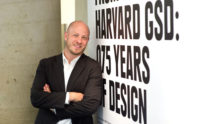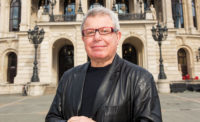Tomas Koolhaas remembers when his father, architect Rem Koolhaas, was laying the groundwork for his firm Office for Metropolitan Architecture (OMA) in their London apartment. As a youngster, Tomas was allowed to doodle on the office drafting boards and shovel alongside construction workers. Both parties branched out: OMA became a ubiquitous international architecture firm, and Tomas pursued his interest in media and film. Now, after 10 years in cinema, Tomas, 33, is returning to his roots. For the past two years, the Santa Monica–based filmmaker has been piecing together REM, a feature-length documentary about his father, his father’s buildings, and—most importantly—the people around them. With a grant, a successful Kickstarter campaign, and only two more shoots to go, Tomas hopes to have the final version ready next year. RECORD caught up with Koolhaas the Younger.
Why was this the right moment to make this film?
I think this was a really good time to make a film about Rem; he is working in a lot of different cultures and conditions and doing projects now that are unlike what he has done before. The film’s been something that has been coming together in my mind for a long time. I have, of course, been exposed to Rem’s buildings since I was a kid.
Could you tell us about the central theme of the film?
I am trying to convey something that has really been missing from a lot of architecture documentaries, and that is people. In most films, 80 percent is made up of talking-head interviews, and the other 20 percent is made of graphic images or empty shots of the buildings. They have some useful, interesting intellectual information in them, but they are quite one-dimensional and dry. I never felt that they were touching, or very evocative, or very visually stimulating. What I set out to do was show all of these things, which I have seen at every one of Rem’s buildings. I have heard loads of touching human stories, and seen beautiful images, beautiful scenes, beautiful shots. I think it’s a shame and a waste for everyone else to miss those.
How did you go about choosing your subjects—both buildings and people?
I went to pretty much every single one of the big and important buildings, and even the ones that people don’t think are as important. For instance, I went to the Nexus [World] Housing in Japan, which has been inhabited for 20 years or so. Twenty years of stories and changes have been going on in and around the building and to the building. So I thought that was an interesting story to cover, even though it’s not one of Rem’s most famous or popular projects. I didn’t select anything beforehand; I just went and saw what was there, and then used what I could. I tried not to impose some kind of preconceived narrative on it.
Your encounters with these buildings started from a very young age.
People’s parents’ professions are obviously very much a part of their upbringing. When I was small, Rem had a very small office in London, and I would go to OMA, and they would give me one of those drafting tables, and I would just draw on that. I remember going to the House in Bordeaux when I was very young and actually helping the construction guys build—carrying bags of sand, digging stuff up. So I have had a physically direct relationship with these buildings.
Was there pressure for you to go into architecture?
Definitely not. If anything, it might have been the opposite. People ask me that all the time, and I can’t really explain it, but I have never had any inclination to be in architecture whatsoever. And obviously not in a negative way—it just wasn’t anything I was interested in doing. To what degree [that’s from] seeing Rem’s professional life unfold—what kind of effect that had—I can’t really say. It’s definitely a difficult profession to be in. Even though Rem’s been successful, seeing him and his work, and the real raw, behind-the-scenes version of that, I don’t think that necessarily would have drawn me toward it.
What was Rem’s reaction when you approached him with the idea of the film?
I wouldn’t say skeptical, but he was definitely cautious at first, and I was too. We both had to think long and hard about doing it. I don’t think he had doubts about my ability, but the concern was that it is inherently risky to combine your family and your work life—especially something like this, you know?
Speaking of combining work and family, how would you respond to critics who raise this question of bias in the film, given your close relationship to your father?
I think the whole idea of bias is a bit nonsensical because everyone has bias. It’s almost impossible to be completely scientific and subjective. But having said that, one way I address that issue is by not imposing any perspective on the film, to a degree that’s possible. Of course every editorial decision and every shot you can say is infused with your own subjective perspective. But as much as possible I am not trying to direct the footage in any certain way, or guide the viewer to some sort of leading narrative. I am not going to narrate the piece and I am not going to be on camera.
What were some of the more poignant moments for you while shooting? Did you start to experience these buildings differently after conversing with all of these people?
The one thing that always stands out in my mind was the interview I did with the homeless guy in Seattle, not just from an architectural perspective. It was interesting to hear how much of an impact small design choices have on his life. But also on a personal level, it was very touching to see this guy, hear his story, hear how he ended up there, and I think that kind of connection between us—the filmmaking crew and him—was very poignant for him.
How has making this film affected your relationship with your father?
I think we definitely got closer over the process of making a film. Rem has a particular vision and he doesn’t necessarily like getting filmed by anyone, and he particularly doesn’t like being filmed by camera crews in any invasive ways over long periods, because he is a very private person. I think the fact that I was filming lessened that, though, because he is comfortable around me. There were definitely times where he would have rather been alone and not be filmed, but either way it worked for the film, and either way it works out for us, because we have that level of comfort and understanding.
What was it like working with Kanye West?
It was good. Kanye was very nice, very accommodating. I thought when I interviewed him that he seemed very humble when he was talking about architecture at least. Everything he said made perfect sense to me. I enjoyed the interview and thought it was useful.
People commented online that I shouldn’t have interviewed him for the film, “What does he have to do with Rem?” And it’s just weird because I interviewed a homeless guy, I interviewed construction workers, I interviewed people that have lived in the buildings for 20 years. Kanye worked with Rem on a very cool and innovative project, which was the Cannes pavilion, It would be strange if I didn’t interview him.
What else can we expect for the final product?
You can expect to hear from people that live and work around CCTV, and the people who live in the Nexus building, the Bordeaux building, the Paris building. I think you can really expect to get a deep understanding of the architecture from the people who use the buildings. I am hoping it will come out next year.
Have you shown Rem the footage of what you have shot thus far?
He has seen the clips of what I have released online. I try not to show too much, because I don’t want to prejudice anything for future shoots. I am shooting this film, we agreed on something that would work in the beginning, and agreed on parameters for that. I am free to make this film however I want. I don’t want him to be in a position where he is giving an opinion about a film that’s about him. Ultimately he’s not involved creatively in the direction I take, or the choices I make.
After this film what’s next for you? Are you going to try to make more architecturally related films?
I don’t think this will be the end of this kind of filmmaking for me—the concept of focusing on the human condition, and the human experience of the building, more than the hyper-intellectual aspects of it.














